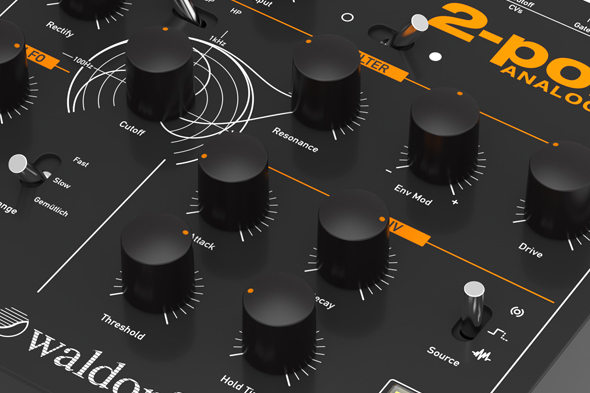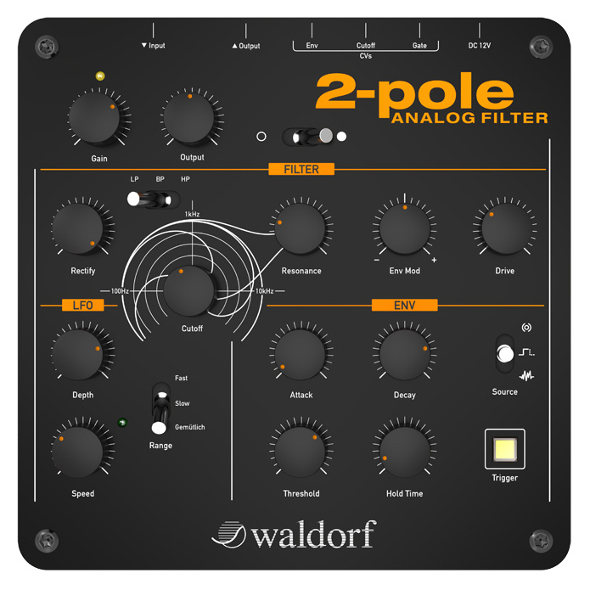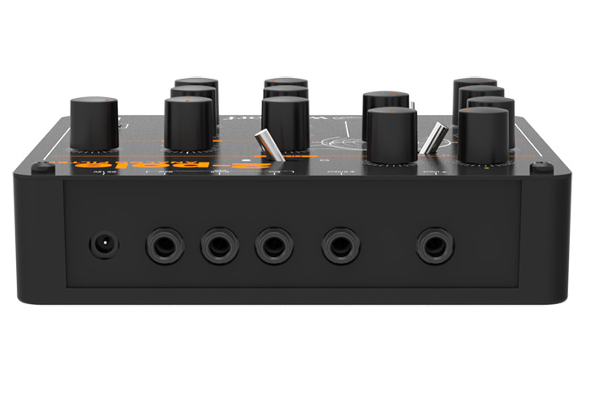Waldorf – 2-Pole Analog Filter

With a healthy legacy behind it, including some iconic synthesizers, Waldorf presents its new analog filter. Rob Lee explores the possibilities presented in this tough little box.
German brand Waldorf has been producing high quality synthesizers since way back in 1980 when it developed the much lauded PPG Wavecomputer, a unit that was given a faithful virtual reconstruction in 2000 as the PPG Wave 2.V. Waldorf’s legacy also includes the innovative Microwave synthesizer, the sought-after Wave synth and more recently the Blofeld, which on release soon became a firm favourite with sound designers the world over. Despite a recent trend for smaller synths and modules, Waldorf has managed to stay relevant with the development of the Rocket analog synth and Streichfett string synthesizer, and it’s alongside these two simple machines that the new 2-Pole filter finds itself placed.
As with those simple units, the 2-Pole is a simple synth with a multi-mode filter featuring a gentle -12dB slope per octave with selectable low pass, band pass and high pass filter modes, as well as two kinds of distortion. There is an envelope section that lets you control the attack and decay with various sources of implementation, and there is also a single LFO with control over depth and speed. Users of the Rocket and Streichfett synths will be right at home with the 2-Pole, which comes packed into the same kind of lightweight metal box with the same design of knobs and controls. Furthermore, the interface keeps to the philosophy of one control surface for one function, making the unit easy to use straight out of the box whether you’re experienced with Waldorf products or not.

The filter section features all the cutoff and resonance controls that you would expect to find, and a quick sweep with full resonance reveals an incredibly smooth sound, even in self-oscillation. The low pass, band pass and high pass mode switch is sturdy and clearly marked, and to help you get complete control of the filter architecture, there is an envelope modulation knob that swings from minus to plus. A crystal clear filter is a wonderful thing, but for those who want a dirty or smudgier kind of sound, Waldorf have included two different kinds of distortion in their circuit design, both controllable from dedicated knobs.
The first of these types of distortion is a pre-filter drive labelled Rectify, which alludes to the kind of waveform that this type of drive produces, capable of rough crushed sounds that give the top end a distinctive crunch. If you are looking for a different kind of edge then Waldorf have also furnished this unit with a post-filter drive that is less subtle, delivering a weightier type of distortion. Control of the levels going in and coming out of the 2-Pole filter are assisted by a dedicated input gain with an LED for visual feedback, an output knob and an activation switch for toggling a clean signal.
For more advanced modulation there is a single LFO, which despite only allowing for a single triangle shape, has plenty of controls that provide a wide variety of effects. There are three speed modes, labelled Fast, Slow and Gemutlich (which translates as cosy), along with an individual speed knob that controls the rate of oscillation within each mode. The depth control gives you hands on command of the width of each oscillation, and with some careful manipulation any number of interesting sounds can be created by the 2-Pole. The fast mode is exceptionally fast, so fast in fact that it’s possible to get some heavily crushed sound effects. The slow speed mode on the other hand will allow you to get more wobbly sounds, while the Gemutlich mode gives you much more languid oscillations. The envelope section is deceptively simple in design but it comes with plenty of interesting and complex possibilities. There are three envelope settings including an envelope follower (driven by the input signal alone, thus only allowing manipulation using the attack and decay knobs), gate trigger and pulse trigger, both of which are controlled by the hold time and threshold control. Manipulating these controls allows you to get some interesting beat slicing sounds and gate type effects.

The CV connections for envelope, cutoff and gate on the rear add to the versatility of the 2-Pole. For instance, a synth pad can be put through the filter, with the kick drum from your project routed to the envelope CV for creating side-chained and gated sounds. If you are a guitarist, you may want to warp your guitar sound using the 2-Pole, controlling the envelope or cutoff using a pedal for added hands-free manipulation. If there is one gripe about the 2-Pole however, it lies in the fact that although the unit cascades stereo, there is only a single input and a single output, which means that connecting to anything stereo will require messing around with various cables. However, the wide variety of filter effects, beat slicers and bit crushed sounds that can be made using this unit more than makes up for this small inconvenience.
The Waldorf 2-Pole is not alone in the market of analog filters. Moog’s Moogerfooger MF101 for instance already has a large amount of fans, but lacks the multi-mode features of the 2-Pole, having only a single low pass filter. It should also be noted that the Waldorf unit is very sensibly priced, making it particularly accessible to those on a budget. Perhaps less like the Moog and Waldorf units is the Moonwind from bespoke German brand Jomox, which features a step sequencer filter with two analog multi-mode filters as well as digital effects. However, it’s the unique range of sounds the 2-Pole’s filter can create that makes it well worth a look if you’re looking for something a little more unusual from a standalone filter unit.
Rob Lee
More info/BuySpecifications:
| Power | 12V DC |
| Filter | Analog multi-mode filter (LP,BP,HP) |
| Envelope | Pulse, Gate, Envelope follow |
| LFO | Triangle shape, Fast, Slow, Gemutlich speeds |
| Drive | Rectify pre-filter drive, post-filter drive |
| Controls | Gain, Output, Activation switch, Rectify, multi-mode filter switch, cut-off, resonance, envelope modulation, drive, LFO depth, LFO speed, LFO range switch, Env attack, Env Decay, Env mode switch, trigger button, Env threshold trigger, Env hold time. |
| Connections | 1 x 1/4″TRS input, 1 x 1/4″ TRS output, Env CV, Cutt-Off CV, Gate CV, power port |
| Dimensions (cms) | 33x23x13 |
| Weight (kgs) | 1.5 |